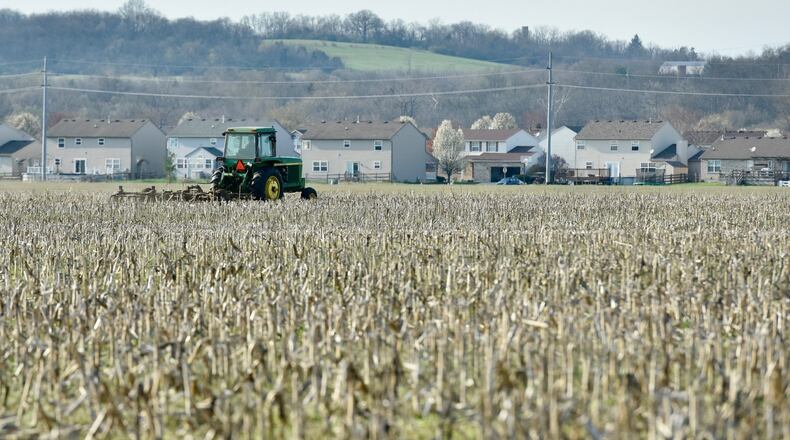Mid-April to mid-May is the most ideal time to plant, said Sam Custer, Darke County Ohio State Extension educator, but moist soil is likely to prevent some area farmers from planting until the start of May. Once May 15 hits, farmers begin losing an average bushel of corn per acre each day, Custer said.
Farmers will also lose a bushel of soybeans every three days if planting happens too late in the season, Greene County farmer Craig Corry said.
“The long-term forecast is for a wet April here, so guys are getting a little anxious,” Custer said.
February was the third wettest ever for the region, and soil moisture remains much higher in the Miami Valley today that usual, said Storm Center 7 Meteorologist McCall Vrydaghs.
»BIZ BEAT: Owner of Kay Jewelers, Jared plans more than 150 closures
There’s also an above average chance that the Miami Valley will have a wetter than normal spring and early summer, according to both the National Oceanic and Atmospheric Administration and Vrydaghs.
“Some people are small farmers that are very financially well off and they can afford to take that one bushel off. But if you’re a new farmer, young, just out of school, and you’re trying to get started, it doesn’t matter what the size, every bushel you’ve got to have to be able to make ends meet,” Custer said.
But it’s still early, said Butler County’s Farm Bureau president and farmer Gail Lierer. Most farmers are optimistic and won’t start getting too concerned until this time next month.
The end of the first week of May is when Corry said he would start feeling the urgency, but some farmers with more acres than him have already started trying to get into the fields as early as possible, including Thursday ahead of Friday’s rain.
»RELATED: Dayton Mall launches new family-friendly entertainment option
Worrying about rain in May is always a concern Lierer said she hears from farmers because they don’t want to stop planting once they’ve started. The hope is for a dry May for planting and enough rain into July to help the crops grow.
“If we get into a situation where it’s a delayed planting and then if we don’t get those rains in July…we’ll probably see some (farmers who are already financially distressed) that will have to change careers. Or they’ll have to pick up a second job in a farm and also work in town at a factory or some other business,” Custer said.
Over the years, many farmers have picked up second jobs to diversify, said Butler County Farmer Rita Biser. She and her family also raise livestock to help offset fluctuations in crops. Others operate excavating businesses because they’re good at operating machinery, she said.
Some will sell crop insurance or sell seed.
If the weather cooperates with a few dry, sunny and windy 70-degree days to dry out the soil, along with another 10 dry days to plant, the window of opportunity is still available for the similar high yields harvested last year.
“You can have good yields, but you also need the good prices to keep everything working good together. It doesn’t matter how much you have, if you’re not getting a good price for it you’re still struggling to make it cost effective,” Lierer said.
»BIZ BEAT: Area Walmart stores part of major technology upgrade across Ohio
Tariffs had a major effect on soybean prices that were already dropping, Lierer said. The trade war caused China to drastically drop the amount of soybeans it purchased from the U.S. and it began looking to Brazil to fill its gap.
Decreased demand from China along with increased supply — both from last year’s record yields leftovers and a good season for Brazil’s crops — has crop prices low at the start of the planting season. Farmers selling soybeans got an average $8.95 per bushel Thursday, compared to $10.61 this time last year and $15.14 five years ago, according to Nasdaq. Corn prices have dropped more than 27 percent over the past five years.
Friday’s prices were $3.60 a bushel compared to $4.95 a bushel.
“Farmers typically spend their profits in the communities they live, so if there’s not good profits made, then they’re not going to buy new cars and trucks, they’re not going to buy new farm equipment, they’re going to eat out less at the restaurants, they’re going to do less socially, they’re going to be in a position where they’re not able to make as large of charitable contributions whether it’s for their church or other nonprofits,” Custer said.
FIVE FAST READS
• Prominent Oakwood boutique set to close
• $3 a gallon gas could be on the horizon sooner than you think
•Dayton Mall launches new family-friendly entertainment option
• Ohio Senate panel OKs 6-cent hike in gas tax
• DSW rebranding under a new company name
By the numbers
$8.95: Average cost per bushel of soybeans now
$10.61: Average cost per bushel of soybeans last year
27: Percent decline in corn price over past 5 years
10: Days it takes most farming operations to finish planting
6.15: Inches of rain in February in the Dayton-area
About the Author
